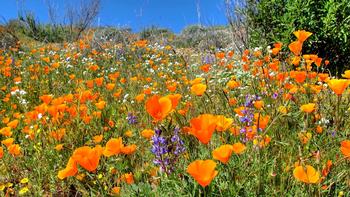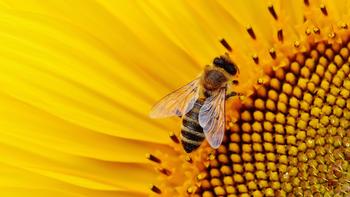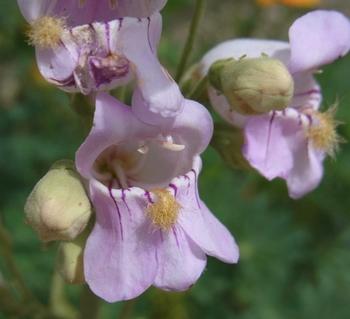
Flowers allow a plant to attract pollinators and reproduce. Photo: tdlucas 5000
Writers have waxed poetic about flowers since quill touched parchment – “a rose by any other name” and all that. But flowers only exist for one reason: reproduction. They lure pollinators that spread pollen from male to female flower parts, which ultimately allows future generations to exist. Bottom line? They’re survival devices.
Those innocent-looking petunias are holding signs that scream, “CHOOSE ME!”
Bet you never realized your backyard was a horticultural dating site.
And thank goodness it is because, without flowers and pollinators, humans would cease. Almost 80 percent of our food and plant-based industrial products require pollination by insects, mammals, and other creatures. We need flowers to – ahem – keep the light on for prospective customers.
Fortunately, flowers are excellent temptresses, with proven strategies for seducing passersby.

Flowers co-evolved with pollinators over many years. Without pollinators, life on Earth would cease. Photo: pixels
Petals are key. Like sequined gowns, their bright colors attract attention. Some have ultraviolet pigments only insects can see. Others have markings or patterns called nectar guides that provide explicit directions. The reward for dropping by? A sweet sip of scrumptious nectar.
Size and shape also matter. Hummingbirds prefer tubular flowers to accommodate their long beaks and tongues. Bees frequent daisy-like flowers and those with a bowl or globe shape. Butterflies appreciate wide landing pads created by tight flower clusters.
Plants and pollinators have co-evolved over millions of years, resulting in the remarkable array of colors and scents surrounding us. Bloom times have also evolved, assuring a year-round buffet and reduced competition for pollinators.
It’s a non-stop game of you-scratch-my back-I’ll-scratch-yours: the pollinators gladly dive into nectar and pollen, and the flowers get to live on. Botanists call this a mutualistic relationship.
This relationship has endured since the first flowers appeared 130 million years ago. That sounds like a long time ago, but geologically speaking, it’s a snap of the fingers. National Geographic’s Michael Klesius puts it in perspective: “If all Earth’s history were compressed into an hour, flowering plants would exist for only the last 90 seconds.”
Prior to their arrival, planet Earth was covered with ferns, mosses, and conifers. I love picturing this transformation, like a coloring book emerging one delightful page at a time.
Today, all 300,000 species of flowering plants, called angiosperms, make up 80 percent of the world’s green plants.

Some flower petals have nectar guides that provide explicit directions for pollinators. Photo: UCANR
Interestingly, pollinators and people don’t always have the same taste in flowers. People often seek plants with astounding flowers – the more mind-blowing, the better. These are usually cultivars – that is, plants that have been intentionally manipulated. Take the iconic bright orange California poppy, a beacon for bees, now available in cultivars like ‘Ivory castle’ (bred for white flowers) and ‘Rose chiffon’ (bred for pink multi-petaled flowers).
The flowers of cultivars may look great in a vase, but pollinators may find them less alluring. Generally speaking, the more altered a plant is, the less attractive it becomes to pollinators. Plus, altered plants may provide less pollen and nectar, which forces pollinators to work harder. It’s not that cultivars don’t attract any pollinators; it’s just less of a sure thing.
Best advice? For maximum pollinator appeal, start with native plants. But be sure to leave some room for your favorite exotic, can’t-live-without-them flowers.
Aside from their critical environmental role, flowers have played starring roles in history, mythology, literature, medicine, art, and beyond. Think van Gogh’s sunflowers and Georgia O’Keeffe’s close-ups. Chamomile for sleep and Digitalis for the heart. Narcissus adoring his reflection, and Mexicans celebrating the Day of the Dead wearing crowns of carnations. Stone carvings of lotus flowers on ancient Egyptian columns and cherry blossom paintings in Japan.
Like a good friend, flowers can elicit happy emotions. Studies show that having flowers around the house lifts your mood, lowers your chances of experiencing stress-related depression, and helps you feel relaxed. All that without any medicinals!
Whether you like them big and bold or dainty and demure, there’s no denying that flowers bring joy to the heart and beauty to the Earth.
 Flowers allow a plant to attract pollinators and reproduce. Photo: tdlucas 5000Those innocent-looking petunias are holding signs that scream, “CHOOSE ME!”Bet you never realized your backyard was a horticultural dating site.And thank goodness it is because, without flowers and pollinators, humans would cease. Almost 80 percent of our food and plant-based industrial products require pollination by insects, mammals, and other creatures. We need flowers to – ahem – keep the light on for prospective customers.Fortunately, flowers are excellent temptresses, with proven strategies for seducing passersby.Petals are key. Like sequined gowns, their bright colors attract attention. Some have ultraviolet pigments only insects can see. Others have markings or patterns called nectar guides that provide explicit directions. The reward for dropping by? A sweet sip of scrumptious nectar.
Flowers allow a plant to attract pollinators and reproduce. Photo: tdlucas 5000Those innocent-looking petunias are holding signs that scream, “CHOOSE ME!”Bet you never realized your backyard was a horticultural dating site.And thank goodness it is because, without flowers and pollinators, humans would cease. Almost 80 percent of our food and plant-based industrial products require pollination by insects, mammals, and other creatures. We need flowers to – ahem – keep the light on for prospective customers.Fortunately, flowers are excellent temptresses, with proven strategies for seducing passersby.Petals are key. Like sequined gowns, their bright colors attract attention. Some have ultraviolet pigments only insects can see. Others have markings or patterns called nectar guides that provide explicit directions. The reward for dropping by? A sweet sip of scrumptious nectar. Flowers co-evolved with pollinators over many years. Without pollinators, life on Earth would cease. Photo: pixelsSize and shape also matter. Hummingbirds prefer tubular flowers to accommodate their long beaks and tongues. Bees frequent daisy-like flowers and those with a bowl or globe shape. Butterflies appreciate wide landing pads created by tight flower clusters.Plants and pollinators have co-evolved over millions of years, resulting in the remarkable array of colors and scents surrounding us. Bloom times have also evolved, assuring a year-round buffet and reduced competition for pollinators.It’s a non-stop game of you-scratch-my back-I’ll-scratch-yours: the pollinators gladly dive into nectar and pollen, and the flowers get to live on. Botanists call this a mutualistic relationship.This relationship has endured since the first flowers appeared 130 million years ago. That sounds like a long time ago, but geologically speaking, it’s a snap of the fingers. National Geographic’s Michael Klesius puts it in perspective: “If all Earth’s history were compressed into an hour, flowering plants would exist for only the last 90 seconds.”Prior to their arrival, planet Earth was covered with ferns, mosses, and conifers. I love picturing this transformation, like a coloring book emerging one delightful page at a time.Today, all 300,000 species of flowering plants, called angiosperms, make up 80 percent of the world’s green plants.Interestingly, pollinators and people don’t always have the same taste in flowers. People often seek plants with astounding flowers – the more mind-blowing, the better. These are usually cultivars – that is, plants that have been intentionally manipulated. Take the iconic bright orange California poppy, a beacon for bees, now available in cultivars like ‘Ivory castle’ (bred for white flowers) and ‘Rose chiffon’ (bred for pink multi-petaled flowers).
Flowers co-evolved with pollinators over many years. Without pollinators, life on Earth would cease. Photo: pixelsSize and shape also matter. Hummingbirds prefer tubular flowers to accommodate their long beaks and tongues. Bees frequent daisy-like flowers and those with a bowl or globe shape. Butterflies appreciate wide landing pads created by tight flower clusters.Plants and pollinators have co-evolved over millions of years, resulting in the remarkable array of colors and scents surrounding us. Bloom times have also evolved, assuring a year-round buffet and reduced competition for pollinators.It’s a non-stop game of you-scratch-my back-I’ll-scratch-yours: the pollinators gladly dive into nectar and pollen, and the flowers get to live on. Botanists call this a mutualistic relationship.This relationship has endured since the first flowers appeared 130 million years ago. That sounds like a long time ago, but geologically speaking, it’s a snap of the fingers. National Geographic’s Michael Klesius puts it in perspective: “If all Earth’s history were compressed into an hour, flowering plants would exist for only the last 90 seconds.”Prior to their arrival, planet Earth was covered with ferns, mosses, and conifers. I love picturing this transformation, like a coloring book emerging one delightful page at a time.Today, all 300,000 species of flowering plants, called angiosperms, make up 80 percent of the world’s green plants.Interestingly, pollinators and people don’t always have the same taste in flowers. People often seek plants with astounding flowers – the more mind-blowing, the better. These are usually cultivars – that is, plants that have been intentionally manipulated. Take the iconic bright orange California poppy, a beacon for bees, now available in cultivars like ‘Ivory castle’ (bred for white flowers) and ‘Rose chiffon’ (bred for pink multi-petaled flowers). Some flower petals have nectar guides that provide explicit directions for pollinators. Photo: UCANRThe flowers of cultivars may look great in a vase, but pollinators may find them less alluring. Generally speaking, the more altered a plant is, the less attractive it becomes to pollinators. Plus, altered plants may provide less pollen and nectar, which forces pollinators to work harder. It’s not that cultivars don’t attract any pollinators; it’s just less of a sure thing.Best advice? For maximum pollinator appeal, start with native plants. But be sure to leave some room for your favorite exotic, can’t-live-without-them flowers.Aside from their critical environmental role, flowers have played starring roles in history, mythology, literature, medicine, art, and beyond. Think van Gogh’s sunflowers and Georgia O’Keeffe’s close-ups. Chamomile for sleep and Digitalis for the heart. Narcissus adoring his reflection, and Mexicans celebrating the Day of the Dead wearing crowns of carnations. Stone carvings of lotus flowers on ancient Egyptian columns and cherry blossom paintings in Japan.Like a good friend, flowers can elicit happy emotions. Studies show that having flowers around the house lifts your mood, lowers your chances of experiencing stress-related depression, and helps you feel relaxed. All that without any medicinals!Whether you like them big and bold or dainty and demure, there’s no denying that flowers bring joy to the heart and beauty to the Earth.
Some flower petals have nectar guides that provide explicit directions for pollinators. Photo: UCANRThe flowers of cultivars may look great in a vase, but pollinators may find them less alluring. Generally speaking, the more altered a plant is, the less attractive it becomes to pollinators. Plus, altered plants may provide less pollen and nectar, which forces pollinators to work harder. It’s not that cultivars don’t attract any pollinators; it’s just less of a sure thing.Best advice? For maximum pollinator appeal, start with native plants. But be sure to leave some room for your favorite exotic, can’t-live-without-them flowers.Aside from their critical environmental role, flowers have played starring roles in history, mythology, literature, medicine, art, and beyond. Think van Gogh’s sunflowers and Georgia O’Keeffe’s close-ups. Chamomile for sleep and Digitalis for the heart. Narcissus adoring his reflection, and Mexicans celebrating the Day of the Dead wearing crowns of carnations. Stone carvings of lotus flowers on ancient Egyptian columns and cherry blossom paintings in Japan.Like a good friend, flowers can elicit happy emotions. Studies show that having flowers around the house lifts your mood, lowers your chances of experiencing stress-related depression, and helps you feel relaxed. All that without any medicinals!Whether you like them big and bold or dainty and demure, there’s no denying that flowers bring joy to the heart and beauty to the Earth.


